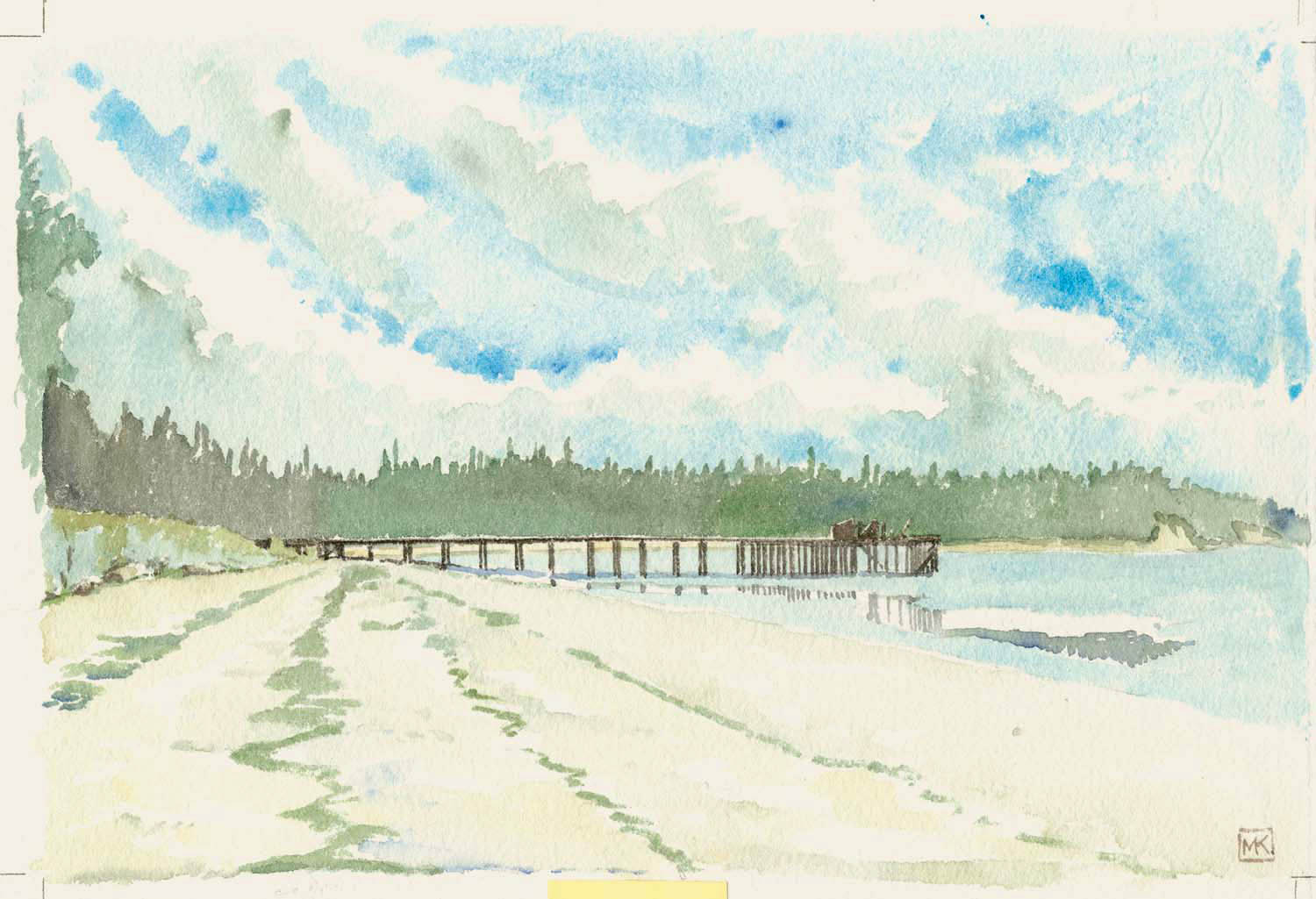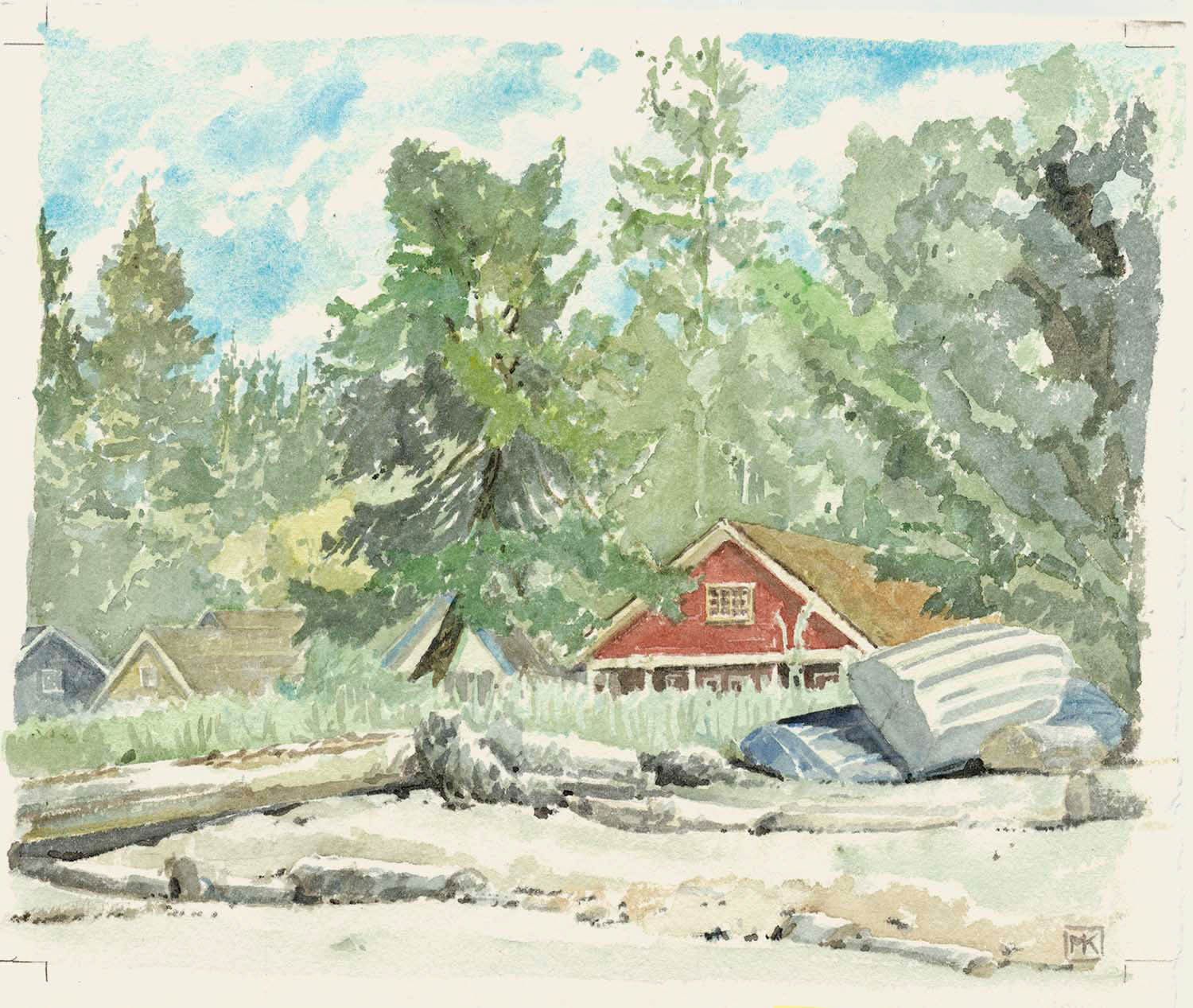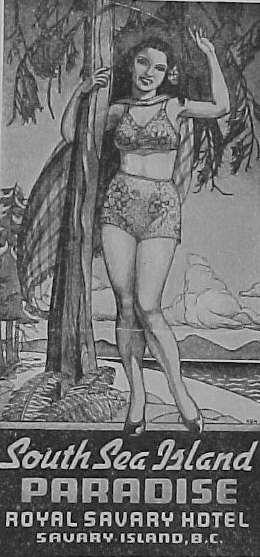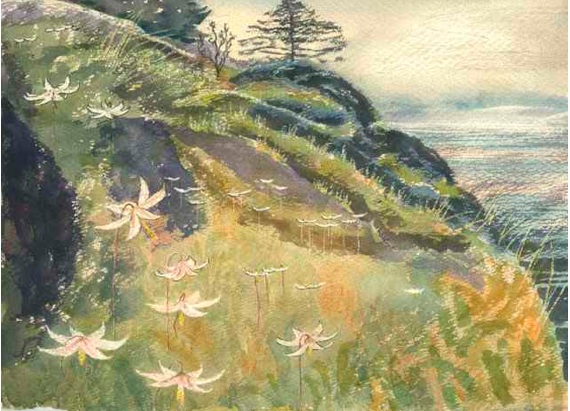Return to main Vanishing B.C. page Return to home page
Page last updated June 28, 2010
© Michael Kluckner
|
The watercolours on this page are all from more or less the same spot – the beachfront where Townley Walk meets the shore road now called Malaspina Promenade. This is the historic section of cottages from the 1920s and 1930s (the razed Royal Savary Hotel, referred to in the brochures below, was way off in the right distance of the beach sketch at the west end of the island). Savary, checkerboarded with small, city-sized lots only some of which have been cleared and developed, was subdivided in 1911-12 by the Savary Island Syndicate headed by Harry Keefer; it also developed the original Savary Inn and attempted to provide such infrastructure as a communal water supply. Although little more than a huge sandbar, the island actually has an excellent aquifer, with individual wells never running dry in the summer (unlike those on many of the Gulf Islands). The former government wharf where the water taxi lands points across the strait toward Lund. The first permanent house on the island, built about 1910 by Louis Anderson, is a little way past (on the far side) of the wharf, while the Spilsbury family's old home stands at the T of the wharf and the road. (See Spilsbury's Album by Jim Spilsbury, Harbour, 1990, pp. 22-3). An old concrete sidewalk, hand-built by the cottagers so they could more easily move their goods in wheelbarrows from the wharf, runs along the shoreline. It is now overgrown and unused, as there are many cars on the island (landed by barge on the beach) and a taxi service. See also my paintings from another trip to Savary in the travel section. |


|
The most visually pleasing set of cottages lines the beach on narrow lots near Townley Walk. The red-painted one is "Kingarth." This scene is about at the middle of the promenade--stretching between the government dock and the tennis courts, that long-time Savary Islander Tony Griffin describes as "a quintessential Martha's Vineyard sort of landscape," where people "walk up and down the street and say hello to everyone" and old rowboats and bleached driftlogs dot the grassy border between the beach and the road. The tennis courts (a few hundred metres to the left of this picture) have a decking of twisted old 2 x 8 boards, leading to the term "the Savary bounce." The above-mentioned Savary Lodge is a further hundred metres past the tennis courts. See the historical note below on "Kingarth." Note from Rick Thaddeus: Kingarth was demolished in September, 2006 The south shore is lined with tall sand cliffs that were remarked upon by Captain Vancouver; Jim Spilsbury wrote of local children, including himself, being employed planting broom to stabilize them. That broom is now rampant on the island, pretty in spring but snuffing out the native vegetation. |
|
|
A 1920s brochure cover. Collection of Tony Griffin |
|
|
1920s or possibly early 1930s brochure and timetable. Collection of Tony Griffin. Since the end of the Union Steamships era in the late 1940s the island has only been served by watertaxi from Lund, and by the "Daddy planes" that bring vacationers and summer commuters on weekends. |
 |
The cheaply produced brochure on the left is likely from the 1950s, cashing in on the Polynesian craze fueled by the movie "South Pacific." The brochure illustration below is 1960s-vintage. |
|
Note from Tony Griffin, 2010: The Savary Island
Heritage Society is delighted to announce that 'Helen Griffin's
Savary Island' has been printed and is now ready for delivery!
We are thrilled with the results.  (watercolour by Helen Griffin)
(Contact information: Savary Island Heritage Society, P.O. Box 120, Whonnock, B.C. V2W 1V9). Subdivision: The subdivison of District Lot 1372 and a small part of District Lot 1373 was done by Harry Leroy Jenkins and Mackenzie Urquhart in 1910 and initially land was offered for sale by the Vancouver Trust Company, of which H. L. Jenkins was the President. George Ashworth was neither an officer nor a director of the Vancouver Trust Company, however he was involved in promoting these sales. Within a year or two the land that had not already been sold was acquired by the 'Savary Island Park Association', often refered to as 'The Syndicate' for which R. S. Sherman was the Chairman and Trustee and Bob Townley was the Secretary-Treasurer. George Ashworth, who was Bob Townley's brother-in-law, and Harry Keefer were among the committee members of the 'Savary Island Park Association'. Prior to moving to Savary Harry Keefer had been partner in a Vancouver real estate business with Bob Townley. Once on Savary Harry Keefer acted as the resident manager and became the postmaster and for a time a Justice of the Peace. Although 'The Syndicate' only endured for a few years Harry Keefer continued to personify Savary Island for the following half century. Kingarth (demolished September, 2006): The house was built during the 1910s by W. A. (Bill) Mace based on plans similar to those used for the Edmonds house (two houses to west). Kenneth Lumsden Burnet (1866 - 1954), the original owner, had business associations with R. S. Sherman (1865 - 1941), a major (but now largely forgotten) figure in the early days of the subdivision of Savary, and K. L. Burnet was also acquainted with George Ashworth having met him during the Riel Rebellion. K. L. Burnet was a land surveyor and son of one of B.C.'s very early surveyors Major Peter Burnet (1837 - 1910). R. S. Sherman, who was active as a land surveyor when he first came to B.C. in the 1890s, worked for a time with K. L. Burnet. All three surveyors have obituaries in 'Early Land Surveyors of British Columbia' (John A. Whittaker, ed., Corporation of Land Surveyors of the Province of B.C., 1990). K. L. Burnet's daughter acquired K. L. Burnet's cottage and her husband, John Aiken, named the cottage 'Kingarth' after his birthplace in Scotland. Kingarth is reported to mean 'a small stone hut'. The current owner of Kingarth is a granddaughter of K. L. Burnet. The house next door to the east is the house built for R.S. Sherman and is one of the first six houses that were built soon after the 1910 subdivision. The house two houses to the east, which was owned by Bill Mace, the builder, is now owned by Peter Burnet, a grandson of K. L. Burnet. * * * Note from John Fournier, Guyana, 2005: One thing that I can clarify for you is your tenuous statement about when Union Steamships stopped service to Savary around 1949 (which is correct); you state that from then on it was water taxi access from Lund. The truth is, there was a small coastal vessel company called the Gulf Steamship Lines that ran along the Sunshine Coast well into the 1950's. My father took myself, my brother and sister twice to Savary Island, once in 1951 and again in 1953. We took the boat from Vancouver docks to Savary, with stops at Texada Island and Westview on the way. The name of the little ship was the "Gulf Wing", and it was a converted WWII naval ship. We stayed at the Royal Savary Hotel for about a week each time. They are among the choicest memories of my youth. The Ashworths who owned the hotel were just great people and wonderful hosts. I remember Bill Ashworth picking us up at the pier on the east end in a 1930 Franklin air-cooled sedan and driving the 5 miles over the dirt road to the hotel at the west end. He had two Franklins and a 1929 Packard at the hotel. He and his wife Marian did almost everything themselves, although I remember they had waitresses in the dining room. I wonder what happened to the 2 Franklins and 1 Packard when they closed down the hotel. It would have been expensive to ship them off the island, but Franklins and 1929 Packards have good value in the collector car market, of which I have some expertise. I know Bill Ashworth died some years back, but would be curious if anyone on the island knows of the disposition of these interesting cars. Note from Ken Palfrey: Regarding the old sedans that used to shuttle people from the wharf to the Royal Savary Hotel, I remember their old rusting hulks with big swooping fenders parked along the side of the road, windows smashed out, salal growing out of them. 20 + years ago they were flattened and burried by backhoe, paid for by donation by the community. |
